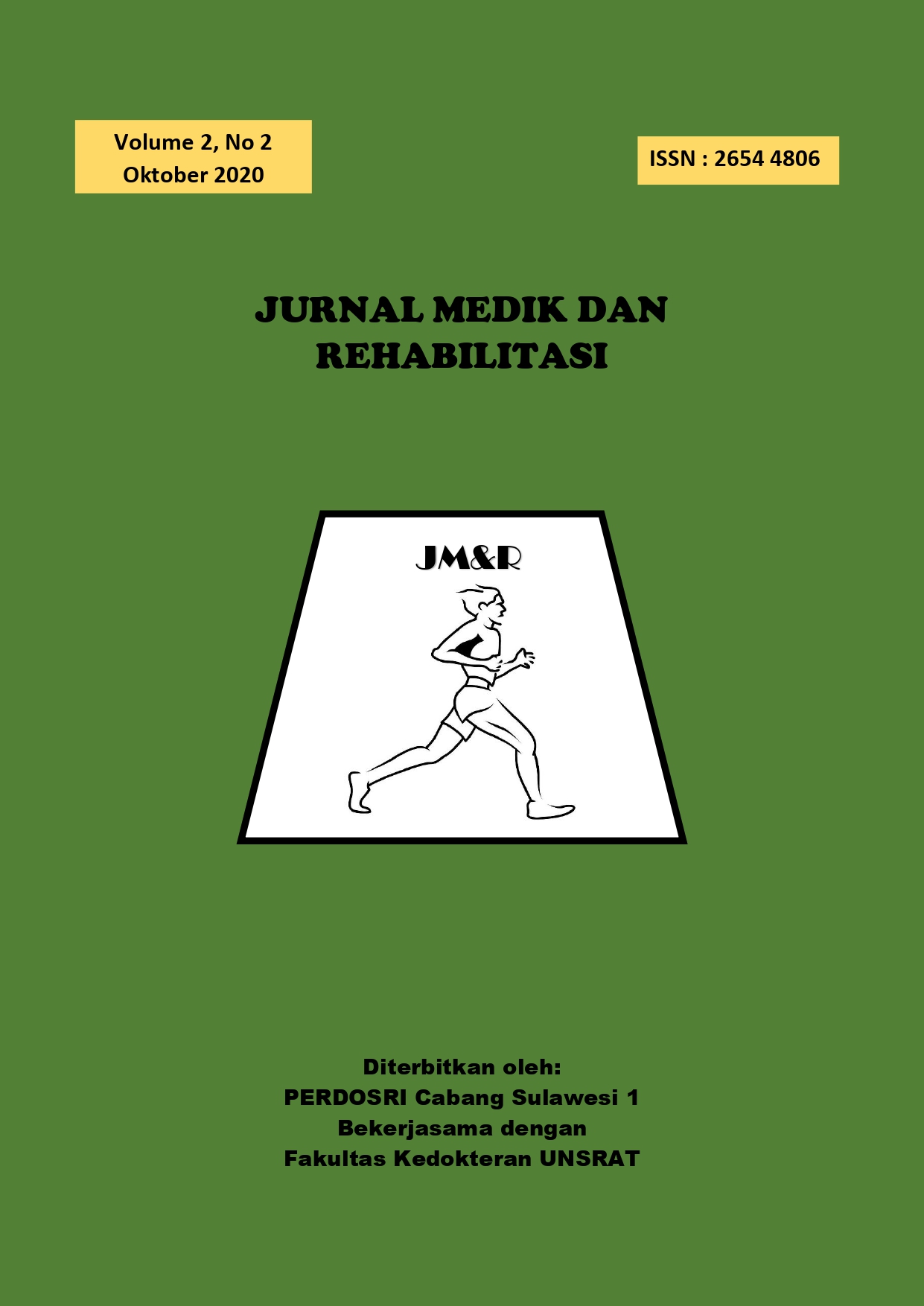Rehabilitasi Medik pada Tortikolis Muskular Kongenital
Abstract
Abstract
Torticollis is a type of postural disorder of the head and neck that most often occurs in infants. Torticollis was first defined by Tubby in 1912 as "a deformity, both congenital and acquired, characterized by lateral tilt from head to shoulder, with torsion in the neck and deviation of the face". The term congenital muscular torticollis (TMK) denotes a neck deformity involving shortening of the sternocleidomastoid muscle (SCM) that is detected at birth or shortly after birth. The term torticollis comes from Latin, from the words torquere meaning to bend, and collum meaning neck and is a clinical sign of an acquired or congenital bent or twisted neck. Congenital muscular torticollis (TMK) or also known as wry neck, colli fibromatosis and twisted neck ranks the top third as a congenital musculoskeletal disorder in neonates after dislocation of the hip and clubfoot and is characterized by lateral flexion of the head towards the side of the affected side and cervical rotation to the opposite side due to unilateral shortening of the sternocleidomastoid muscle (SCM), which is detected at birth or shortly thereafter.
Â
Abstrak
Tortikolis adalah salah satu jenis kelainan postur pada kepala dan leher yang paling sering terjadi pada bayi. Tortikolis dulu pertama kali didefinisikan oleh Tubby pada tahun 1912 sebagai “Deformitas, baik bawaan maupun didapat, yang ditandai dengan kemiringan lateral dari kepala ke bahu, dengan torsi di leher dan deviasi wajah â€. Istilah tortikolis muskular kongenital (TMK) menunjukkan deformitas leher yang melibatkan pemendekan otot sternokleidomastoid (SCM) yang terdeteksi saat lahir atau segera setelah lahir.Istilah tortikolis berasal dari bahasa Latin, dari kata torquere artinya bengkok, dan collum yang berarti leher dan merupakan tanda klinis dari leher bengkok atau terputar yang bisa didapat atau kongenital. Tortikolis muskular kongenital (TMK) atau yang dikenal juga dengan sebutan wry neck, fibromatosis colli dan twisted neck menduduki urutan ketiga teratas sebagai kelainan kongenital muskuloskeletal pada neonatus setelah dislokasi panggul dan clubfoot dan ditandai dengan fleksi lateral kepala ke arah lateral sisi yang terkena dan rotasi servikal ke sisi yang berlawanan karena pemendekan unilateral otot sternokleidomastoid (SCM), yang terdeteksi saat lahir atau segera setelahnya.
References
Amaral D, Cadilha R, Rocha J, Silva A, Parada F. Congenital muscular torticollis : Where are we today ? A retrospective analysis at a tertiary hospital. Porto Biomed Journal. 2019.4:3(e36).
Ross KK. Congenital Muscular Torticollis. Dalam : Campbell SK, RJRJP, Orlin MN, editors. Physical Therapy for Childreen. 4th ed. St Lovis. Elsevier Saunders; 2012.h. 292-312.
Wahyuni LK. Tortikolis Muskular Kongenital. Dalam : Wahyuni LK, Tulaar ABM, editors. Ilmu Kedokteran Fisik dan Rehabilitasi pada Anak. PERDOSRI. 2014. H. 479-496.
Lee JY, Koh SE, Lee IS, Jung H. The cervical Range of Motion as ad factor affecting outcome in patient with congeniotal muscular torticollis. Annal of Rehabilitation Medicine. 2013, 37(2):183-190.
Freed SS, Colleen CB. Identification and treatment of congenital muscular torticollis in infants. JPO Journal of Prosthetics and Orthotics: October 2004 - Volume 16 - Issue 4 - p S18-S23.
Diamond M, Armento M. Children with Disabilities dalam physical medicine and rehabilitation principles and practice. Delisa JA editors. Lippincott Williams & Wilkins Philadelphia, USA. 2005. 1514.
Moore KL, Dalley AF. Clinically Oriented Anatomy, 5th ed: Lippincott Williams & Wilkins; 2006.
Macias CG, Gan V. Congenital Muscular Torticollis. William Philips, MD editors. Updated-Agst 18,2011.
Cheng JCV,SP; Tang TMK; Chen, MWN; Wong, EMC; The clinical presentation and outcome of treatment of Congenital Muscular Torticollis in Infants-A Study of 1,086 Cases. Journal of Pediatric Surgery, Vol 35, No 7 (July), 2000: pp 1091-96.
Chusid JG. Defek congenital dalam neuroanatomi korelatif dan neurologi fungsional bagian dua. Diterjemahkan oleh dr. Andri Hartono. Gajah mada University press, Yogyakarta. 1993. 525.
The TOT Collar by Symetric Designs for Congenital Muscular Torticollis manufactured by www.symmetric-designs.com.800-637-1724.
Oleszek JL, Chang N, Apkon S. Botulinum toxin type A in the treatment od children with torticollis muscular congenital. Am J Phys MedRehabil. 2005; 84:813-6
Öhman AM. The immediate effect of kinesiology taping on muscular imbalance for infants with congenital muscular torticollis. Phys Med and Rehabilitation Journal. 2012;4(7):504-8
Han JD, Kim SW, Lee SJ, Park MC, Yim SY. The thickness of the sternocleidomastoideusmuscle as a prognostic factor for congenital muscular torticollis. Ann Rehabil Med. 2011; 35:361-8
Antares JB, Jones MA, King JM, Chen TMK, Lee CMY, Macintyre S, Urquhart DM. Non-surgical and non-pharmacological interventions for congenital muscular torticollis in the 0-5 year age group. Cochrane Database of Systematic Reviews 2018, Issue 3. Art. No.: CD012987.
Kaplan SL, Coulter C, Sargent B. Physical therapy management of congenital muscular torticollis: a 2018 evidence-based clinical practice guideline from the APTA Academy of Pediatric Physical Therapy. Pediatr Phys Ther. 2018;30(4):240–290
Sargent B, Kaplan SL, Coulter C, et al. Congenital Muscular Torticollis: Bridging the Gap Between Research and Clinical Practice. Pediatrics. 2019;144(2):e20190582
Kwon DR, Park GY. Efficacy of microcurrent therapy in infants with congenital muscular torticollis involving the entire sternocleidomastoid muscle: a randomized placebo-controlled trial Clinical Rehabilitation 2014, Vol. 28(10) 983–991
Petronic I, Brdar R, Cirovic D, Nikolic D. Congenital muscular torticollis in children:distribution, treatment duration and outcome. Eur J Phys Rehabil Med. 2010;46(2):153-7.
Rahlin M, Sarmiento B. Reliability of still photography measuring habitual head deviation from midline in infant with congenital muscullar torticolis.Pediatr Phys Ther.2010;22(4):399-406.

